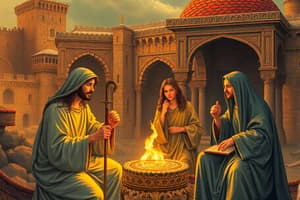Podcast
Questions and Answers
Where did Jesus live during his time?
Where did Jesus live during his time?
Palestine
Name three provinces into which Palestine was divided during the time of Jesus.
Name three provinces into which Palestine was divided during the time of Jesus.
Judaea, Samaria, Galilee
What are the principal towns mentioned in the Gospel story in the province of Judaea?
What are the principal towns mentioned in the Gospel story in the province of Judaea?
Jerusalem, Bethlehem, Ain Karim, Emmaus, Jericho, Bethany
Which province of Palestine was known for being the most favored by nature?
Which province of Palestine was known for being the most favored by nature?
What was the nature of the economy in first-century Palestine?
What was the nature of the economy in first-century Palestine?
What percentage of the population in first-century Palestine was made up of the peasantry?
What percentage of the population in first-century Palestine was made up of the peasantry?
What were the principal products of production in Palestine?
What were the principal products of production in Palestine?
What did the peasants' diet mainly consist of?
What did the peasants' diet mainly consist of?
Who were included in the peasantry?
Who were included in the peasantry?
What was the primary source of income for the elites in Palestine?
What was the primary source of income for the elites in Palestine?
Who proclaimed Herod the Great as the King of the Jews?
Who proclaimed Herod the Great as the King of the Jews?
What were the languages spoken in Palestine during that time?
What were the languages spoken in Palestine during that time?
Flashcards are hidden until you start studying
Study Notes
Geography of Palestine
- The region is also known as the Middle East, with Palestine as its heart, where Jesus lived.
- Palestine was divided into three provinces during Jesus' time: Judaea, Samaria, and Galilee.
- Key towns in Judaea: Jerusalem, Bethlehem, Ain Karim, Emmaus, Jericho, and Bethany.
- Key towns in Samaria: Samaria and Sychar.
- Key towns in Galilee: Cana, Chorazin, Nazareth, Capernaum, Bethsaida, and Tiberias.
Economic Situation
- Palestine's economy was primarily agrarian, based on subsistence-level farming by peasants who made up 90% of the population.
- Principal products: grain, vegetables, fruits, legumes, spices, and meat.
- Peasants' diet consisted mainly of bread, salt, olives, oil, onions, and grapes.
- The economic condition of peasants was precarious due to subsistence-level farming, taxes, rents, and natural disasters.
- Elites drew their income from medium-sized and large estates.
Trade
- Trade was significant, with both local and international trade.
- Principal exports: olive oil, dates, opobalsam, and spices.
Political Situation
- The Roman Empire governed the conquered people wisely, which contributed to their powerful empire.
- Herod the Great, a half-Jew, was proclaimed King of the Jews by Octavian in 31 B.C.
- Herod's territory included Idumea, Judaea, Samaria, Galilee, and north and east of the Sea of Galilee.
- Herod rebuilt the temple, which was completed in 63 A.D.
- Herod was suspicious and reacted violently against any attempt to usurp his power.
- After Herod's death, his kingdom was divided among his sons, with the Roman Procurator governing the territory.
Language
- Hebrew was the sacred language.
- Aramaic was the language of ordinary people.
- Greek was the universal language of the Roman Empire.
- Latin was the language of Roman soldiers.
Studying That Suits You
Use AI to generate personalized quizzes and flashcards to suit your learning preferences.




